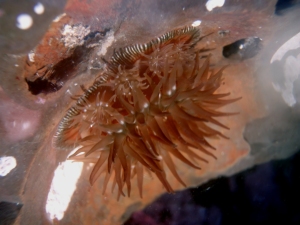
“Improvisation 7.09” by Dominic Minichiello (Cover image for Sex After Life by Claire Colebrook (http://bit.ly/1N4IUbg)
Extinction and mass extinction are complex phenomena that entangle multiple dimensions of life, ethics, politics, economics and art. But how do they relate to gender and sexuality? A few months ago, I was asked to write a chapter for a textbook on gender and nature that would address this question. This was a welcome and stimulating challenge, which gave me the opportunity to dig more deeply into the crossings between feminism, gender studies, queer theory and studies of extinction – fields which are connected in multiple, sometimes not-so-obvious ways. In many ways, this is a project of bridging, extending and teasing out resonances between literatures. Decades of eco-feminisms, feminist environmentalisms and environmental feminisms have produced rich discussions on the relationships between gender sexuality and the ecosphere. However, with the notable exception of Claire Colebrook, very few scholars of gender and queer theory have engaged directly with extinction. The concept does appear in eco-feminist works, but it is almost always invoked rhetorically, as an opaque worst case scenario used to underscore the enormity of destructive power structures and relations. In these discourses (like many others), the concept of extinction is something of a black box, and it most often treated as a non sequitur: it is assumed to mean “the death of every member of a species”, and there is rarely discussion of its many other dimensions, relations and implications. At the same time, emerging work in the humanities on extinction and mass extinction holds great potential for exploring the links between gender, sexuality, survival and extinction that can be nurtured further.
Reflecting on the connections between these fields is not only a promising way of theorising extinction in a more robust and plural way, but it can also contribute to feminist, gender and queer scholarship in rich ways. To this end, I’ve tried to tease out some of the most potent intersections between these fields, bringing them into direct confrontation with extinction, and with existing modes of response to it. Here are a few of the nodes that I think have great potential for further development.
Feminist critiques of neo-liberal conservation
One of the most integral arguments within ecological feminisms is that patriarchal, extractive logics underpin the destruction of ‘nature’. Carolyn Merchant popularized this argument by tracing the roots of the current ecological crisis to the scientific revolution and the rise of capitalism in the early modern period of European history. For Merchant, the transition from a belief system in which the Earth was understood to be a living ‘mother’ to one in which it was refigured as a passive female body removed constraints on destructive activity. From this perspective, the logics and resulting cultures of extractive patriarchy underpin destructive relations between humans and the Earth. Subsequently, authors such as Kay Warren and Val Plumwood have argued that the converse is also true. That is, that the separation of ‘man’ and ‘Earth’ entrenches relations of superiority, subordination and instrumentality that have helped to sustain oppressive gender categories – along with other exclusive categories such as race and species (see the work of Greta Gaard on this subject).
These arguments provide an important basis for critiquing dominant political framings of and responses to extinction and prospect of mass extinction, in particular neoliberal logics of conservation. They suggest that the androcentric, extractive logics that gave rise to early capitalism undergird human activities that may lead to extinction. Yet, as Sian Sullivan’s excellent work attests to, the very same logics of accumulation, extraction and financialization are central to contemporary conservation efforts. In fact, since the inception of the term ‘biodiversity’ in the late 1980s, conservationists have sought to incentivize the protection of diverse life forms by emphasizing their resource value. In these discourses, even non-monetary forms of value – for instance, spiritual, scientific or aesthetic value – are treated as dwindling resources. Conservation, in this context, is framed as a means of accumulating, securing and managing capital in the hopes of a future profit. This logic has become particularly pronounced in discourses of ‘ecosystems services’, which attempt to re-evaluate ecosystems in terms of the ‘free’ services they provide to economies, and incentivise forms of development based on leveraging this ‘capital’.
Ecological feminist arguments focus attention on the cultures, norms and logics that underpin destructive human activity. They also historicize the convergence of the rise of capitalist economic organization, modern patriarchy, the separation of ‘humans’ and ‘nature’ and cultural frameworks that produce the destruction of ecosystems. This line of analysis helps to identify how neoliberal forms of conservation that understand ‘biodiversity’ in terms of capital and resources, in the nature of creative/destructive flows of capital, propel the exact same forces they resist. As a result, extinction is becoming an important propellor of neo-liberal capitalism. So, existing discourses and practices around extinction and the ‘management’ of biodiversity need to be understood as being enfolded in the processes of capitalism, sometimes quite literally. Emerging financial instruments such as ‘biodiversity banking’ and biodiversity derivatives epitomize this framing, but it is also reflected in the broader language and political economy of conservation. By highlighting the historicity, continuities and transformations of the central logics of capitalism and its embeddedness in relations of hierarchy, feminist critiques have an important role to play in re-thinking dominant frames of extinction and the commodification of biodiversity.
The reproduction of survival/ the survival of reproduction
Extinction is almost always understood against the horizon of survival and the imperative to sustain it – at least for life forms deemed to be of value to humans. In many cases, this imperative takes the form of deliberate strategies for enforcing existence. Donna Haraway’s influential book When Species Meet devotes considerable attention to the logics, practices and politics of Species Survival Plans. These plans monitor and enforce reproduction amongst ‘endangered’ species, not least by collecting data on populations, genetic profiles and genetic materials to enable selective breeding. This strategy assumes that all organisms can, should, and can be made to exercise their reproductive capacities in order to resist extinction, and it actively mobilizes members of ‘endangered species’ into this project. In so doing, it helps to entrench norms regarding gender, sexuality and reproductive labour that are deeply entrenched in modern, Western human cultures.
Attention to these programmes highlights an important way in which extinction is gendered in dominant scientific and policy frameworks. Specifically, strategic breeding programmes share in the belief that reproduction is an imperative for those capable of reproducing if ‘the species’ is at risk’. This belief is directly related to Western norms of the reproductive imperative for women. Indeed, Haraway points out that it is precisely “‘woman’s’ putative self-defining responsibility to ‘the species’ as this singular and typological female is reduced to her reproductive function”. In a similar sense, within SSPs and other strategies of enforced survival, entire life forms are reduced to their reproductive capacities. Moreover, programmes of enforced survival can, in the context of sexual reproduction, disproportionately burden female organisms with the task of avoiding extinction. This logic is particularly fraught in discussions of the possibility of human extinction, in which female fertility (captured in the standard policy language of ‘births per woman’) is framed simultaneously as a threat to survival, and the only hope for escaping extinction (see, for instance, Alan Weisman’s comments on this). In these ways, the securitization of survival entrenches the intersectional categories of gender, species and race discussed above.
Dominant discourses of extinction and conservation also entrench and privilege sexual reproduction, in ways that entrench heteronormative assumptions and norms.

Sea anemones reproducing asexually. Courtesy of Wikimedia Commons (http://bit.ly/1MI842n)
This is reflected in the way that the subjects of extinction and conservation are framed. The standard object of conservation is the biological ‘species’, a term which is defined by the ability of organisms to reproduce sexually. As Myra Hird has pointed out, this conception of ‘species’ makes it appear as if sexual reproduction is the ‘best’ means of sustaining the existence of a life form. However, Hird’s work demonstrates that Earthly life forms actually engage in myriad forms of reproduction, from the free exchange of DNA between bacteria to the hermaphroditic practices of some fish. The upshot of these arguments is that Earthly life is sustained through a huge variety of reproductive activities that do not conform to biological understandings of life processes or species. Crucially, Hird argues that there is no necessary hierarchy between forms of reproduction. In Darwinian terms, all species that manage to survive are equally successful. However, by conflating survival with sexual reproduction, existing discourses of extinction embed hetero-normative frameworks that devalue other forms of reproduction. They also reduce reproduction to the imperative to survive, ignoring the myriad cultural, political, aesthetic, sensual and other dimensions of reproduction.
Extinction can be a mother….
In a related sense, feminists and eco-feminists have long problematized the implicit link made between the practices of mothering (attributed uncritically to all females) and ecological sustainability. Indeed, some eco-feminists – Mies and Shiva amongst them – make this a central plank of their arguments and political projects, calling for the mobilization of maternal care as a means of protecting future (human) generations. However, as Cate Sandilands has pointed out, aside from presuming that mothering is a fundamental feature of females in general, this approach does not cross species borders. Instead, she argues, it constrains women’s political action to the private sphere of the family and inter-human interactions. This, in turn, may enact severe cultural constraints on women’s sense of ethico-political agency in the face of the multi-species (perhaps pan-species) phenomenon that is extinction.
At the same time, the maternal archetype is often applied to the Earth as a whole. In some cases, this metaphor has a positive normative valence. For instance, indigenous and campesino-led movements in Ecuador and Bolivia have succeeded in creating new laws which recognize the rights of Pachamama (an Amazonian deity whose name is often translated as ‘Mother Earth’). These movements frame the Earth as a beloved female figure reliant on the protection of her (human) children.

representation of Pachamama. Courtesy of Wikimedia commons (http://bit.ly/1MI7GRj).
A very different narrative can be found amongst the (predominantly male, especially in the field of human extinction) scientists who study extinction. In their discourses, the Earth is often presented as a ‘bad’ mother: that is, a volatile, withholding or even vengeful figure who cares little for humans. For instance, James Lovelock’s famous image of Gaia depicts the earth as a single, living organization that self-regulates myriad complex processes in order to ensure her life, while being indifferent to the comings and goings of the forms of life who compose her. Peter Ward proposes a different planetary avatar: the (once again, ancient Greek) figure of Media, “sorceress, a princess – and a killer of her own children”. In these two cases, extinction (of humans and other species) is understood to be a sign of ‘bad motherhood’. The Earth has shirked, or even subverted, the norms of nurturing and care to which ‘she’ is expected to confirm. Her indifference to the well-being of her ‘children’ is understood to be both cruel and capricious, and her fluctuations are interpreted as acts of revenge. Perhaps surprisingly (given that these arguments are made by self-identified scientists), extinction is presented as the product of emotion, the result of poorly-constrained female subjectivity crying out for the rationalised discipline historically associated with occidental notions of maleness.
These images draw on dominant Western gender stereotypes to portray the female planet as irrational, unstable, or capricious. From one perspective, such images might be subverted in order to unsettle the dominant conceptions of motherhood discussed above. However, in their current form, they gender extinction in a blunt way, framing it as the devastating outcome of allowing female subjectivity free rein. This calls for a re-appraisal of Merchant’s claim (see above) that the rise of modern European society marked the death of the Earth as a mother figure, particularly in industrial and scientific discourses. In these latter discourses, ‘she’ is not only presented as very much alive, but also as destructively deviant. Instead of inspiring care, ‘her’ persistence – her unwillingness to die, perhaps – prompts calls for increased instrumental control amongst these influential scientists. In this sense, ‘mother nature’ is made into the subject of exploitative control, whether dead or alive. Paying attention to this ‘undead’ version of the ‘Earth mother’ highlights the deeply gendered nature of dominant conceptions of extinction itself.
The death of (sexual) difference and the evolution of politics
Extinction does not just involve the death of organisms, but also the destruction of the forms of difference produced by evolution. Elizabeth Grosz re-reads the seminal works of Charles Darwin through the ideas of Luce Irigaray, arguing that evolution has given rise to irreducible sexual difference. Indeed, she argues that
“sexual selection ensures that sexual difference remains…irreducible to and impossible to generalize into a neutral and inclusive humanity. Sexual difference entails that…the human exists in two nonreducible forms… whose interests cannot be assumed to be the same, but may negotiate a common interest in collective survival”
For Grosz, these forms of irreducible difference each produce ‘endless variety’ on each side of the sexual bifurcation – including variations or intersexes that lie between its categories. She contends that Darwin’s notion of sexual selection anticipates one of Irigaray’s central claims: that the irreducibility of sexual difference makes possible the productive inventiveness that yields diverse forms of life as evolution moves through time. Attentiveness to the role of sexual difference in evolution, she claims, can provide the basis for a new feminism rooted in respect for radical otherness. In contrast, we can understand extinction as the ending of these processes, and of the vital, open-ended creativity they embody. From this perspective, extinction destroys the open-ended, creative processes of differentiation made possible by sexual difference. However, it might also form the focal point for new politics based on the recognition and cultivation of qualitative difference in kind – rather than (just) the commodified, financialized units of ‘biodiversity’.
Indeed, scholars of feminism and queer theory who have engaged directly with extinction argue that it can open up new horizons of ethico-political action. The possibility of mass extinction – and human extinction in particular – is often presented as the negation of all political possibility. However, the ‘figural extinction’ (see Colebrook, above) of gendered and hetero-normative conceptions of ‘humanity’ may also open up unprecedented opportunities to transform social norms and power structures that enforce inequalities of gender, sexuality, race and species. It is important to note that ‘figural extinction’ need not involve the biological elimination of homo sapiens or any other species; contemplating it does not require harbouring an extinction-wish. Instead, it points to the dissolution of the idea of a bounded, separate, superior ‘humanity’, and of the socio-cultural frameworks that sustain it.
Indeed, for Colebrook, contemplating the demise of homo sapiens forces one to think about what other kinds of life forms might evolve from, or instead of, ‘humanity’ as we know it. She also questions whether the dominant norm of ‘humanity’ can justify its existence, which is usually simply presupposed to be a cosmic good. Rather than an expression of misanthropy, Colebrook’s question urges humans to think how they might become otherwise. For instance, questioning the survival of humanity-as-it-is might pave the way for “a radical feminism could provide a genuine thought of life beyond the human. Here, there would be no woman who remains close to the earth, life, and cosmos: no woman who provides man with the other he has always required for his own redemption” (see Colebrook 2014).
In a similar sense, Rosi Braidotti ponders concrete, everyday forms of action that can connect the figural extinction of ‘humanity’ to political transformation. Specifically, she suggests that thinking and writing as if ‘humanity’ were already extinct is the ‘ultimate gesture of defamiliarization’. This, in turn, can help humans “think critically about who we are and what we are actually in the process of becoming”. Braidotti believes that engaging in this kind of ethico-political action can produce new modes of community and solidarity based on an “enlarged sense of inter-connection between self and others, including the non-human or ‘earth’ others”. This, in turn, can lead to an understanding of life that affirms and accommodates not only those forms of life that currently exist, but also those to come. Adopting this attitude, she contends, may counter-act the oppressive and often depoliticizing messages of catastrophe, and retrenchments of existing, exclusive forms of humanism, that are often prompted by public discourses on extinction.
For all of these authors, contemplating human extinction need not be a purely morbid or nihilistic pursuit. Instead, it can open modes of being to radical alterity, making possible transformations that are blocked by the firm normative boundaries that bolster modern humanism. Transcending these boundaries can open up diverse forms of life and flourishing that enable wholly new ways of being. From this perspective, extinction need not be simply a matter of death and destruction, but also of creativity, rejuvenation and the realization of possibilities – including radical conceptions of feminism, gender and queer theory.
***
This brief discussion suggests that there are multiple nodes of intersection between feminisms, queer theories and the concept of extinction. By exploring these intersections, it is possible to begin to open up the conceptual black box of extinction by deploying the tools and perspectives developed by decades of research in these fields. However, confronting extinction may also provide rich opportunities for advancing and deepening studies of gender and sexuality. My current research seeks to pluralize conceptions of (mass) extinction and possible responses to it. Instead of attempting to ‘(re)define’ extinction as a unitary concept, its goal is to proliferate public sources of inspiration for understanding and grappling with this phenomenon. I think that further exploration of the intersections briefly outlined here is one important pathway towards this goal.
